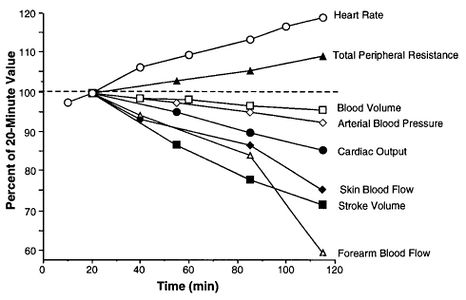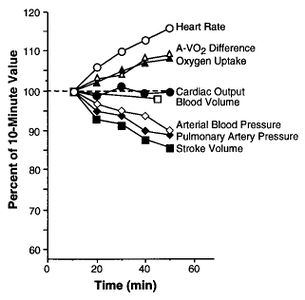Heart Rate Drift
Heart Rate Drift is the reduction in the amount of blood the heart pumps with each beat (Stroke Volume) and the resulting rise in Heart Rate as the heart attempts to maintain the flow of blood (Cardiac Output). This drift starts happening after about 10 minutes of moderate (50-75% V̇O2max) exercise. Heart Rate Drift is also called cardiovascular drift.
Contents
1 Heart Rate Drift, V̇O2max and Maximum Heart Rate
Decreases in stroke volume of 10-16% and increases in heart rate of 12-16% are associated with a 9% to 19% reduction in V̇O2max[1][2][3][4]. Fluid intake[1] or body cooling[3] will mitigate the reduction in stroke volume and V̇O2max. Reducing the exercise load to keep the Heart Rate constant will also mitigate, but not eliminate the reduction in V̇O2max[2]. Heart Rate drift and reduction in V̇O2max is greater in hot than cooler conditions[5]. Heart Rate Drift also increases the Maximum Heart Rate, with one study showing the average Maximum Heart Rate going from 189 BPM to 194 BPM after 45 minutes of exercise[4].
2 Mechanisms of Heart Rate Drift
The traditional explanation for Heart Rate Drift is that blood flow to the skin is increased, which reduces available blood volume for the rest of the body and therefore the ability of the heart to fill with blood, reducing the stroke volume. However, in hydrated subjects, the stroke volume is maintained even though the blood flow to the skin increases[6]. An intriguing study gave subjects either a placebo or a beta blocker then looked at heart rate and stroke volume over the course of 60 min cycling at 57% V̇O2max. With the placebo, the subjects showed the classic heart rate drift, but with the beta blockers, the heart rate and cardiac output remained steady[7]. (In both conditions, the subjects received a carbohydrate drink to prevent dehydration and both conditions had the same perceived exertion.) There is reasonable evidence that the reduction in stroke volume is the result of dehydration and/or overheating (Hypothermia), with each contributing about equally in most cases[8].
3 Heart Rate Drift and Glycogen Depletion
When muscles become depleted of Glycogen a greater percentage of energy comes from fat[9]. However, each liter of oxygen will produce 5 calories of energy when burning carbohydrate, but only 4.6 calories from fat[10]. This means that burning fat produces about 10% less power than burning carbohydrate. If the energy expenditure stays constant then oxygen supply (heart rate, Breathing) has to go up by 10%, which will use a greater percentage of exercise capacity (feeling harder). On the other hand, if oxygen supply (and effort) stays constant, energy expenditure (and therefore pace) will have to drop by 10%. This change in Heart Rate and Breathing can be seen in subjects who are exercising when Glycogen depleted[11]. How would this feel? For a 3:10 marathon runner, it would turn the 7:14 min/mile marathon pace into a 7:54 min/mile pace, or make the marathon pace feel like a 10K pace. (That's 4:31min/Km and 4:56 min/Km.) You can often hear this change in a marathon runner; they will go from relaxed, inaudible Breathing to loud, labored Breathing, and struggle to stay on pace. Glycogen depletion is not the usual cause of Heart Rate Drift, but the symptoms are the same.
4 Detecting Heart Rate Drift with Efficiency Calculations
Because Heart Rate Drift can either show as a rise in Heart Rate for a constant effort, or a stable Heart Rate and a declining effort, it can be hard to see in a simple graph of Heart Rate. A more useful measure is to look at Running Efficiency, which is the number of heart beats taken to run a given distance. This normalizes the heart rate against pace, making heart rate drift more obvious.
5 Heart Rate Drift and the SportTracks Plugin
The SportTracks Dailymile Plugin will calculate Heart Rate Drift and Efficiency Drift given a recording of Heart Rate and pace. The approach uses a least squares calculation to determine the slope of a best fit line through the values.
6 References
- ↑ 1.0 1.1 MS. Ganio, JE. Wingo, CE. Carrolll, MK. Thomas, KJ. Cureton, Fluid ingestion attenuates the decline in VO2peak associated with cardiovascular drift., Med Sci Sports Exerc, volume 38, issue 5, pages 901-9, May 2006, doi 10.1249/01.mss.0000218127.14107.08, PMID 16672844
- ↑ 2.0 2.1 JE. Wingo, KJ. Cureton, Maximal oxygen uptake after attenuation of cardiovascular drift during heat stress., Aviat Space Environ Med, volume 77, issue 7, pages 687-94, Jul 2006, PMID 16856352
- ↑ 3.0 3.1 JE. Wingo, KJ. Cureton, Body cooling attenuates the decrease in maximal oxygen uptake associated with cardiovascular drift during heat stress., Eur J Appl Physiol, volume 98, issue 1, pages 97-104, Sep 2006, doi 10.1007/s00421-006-0249-y, PMID 16896737
- ↑ 4.0 4.1 JE. Wingo, AJ. Lafrenz, MS. Ganio, GL. Edwards, KJ. Cureton, Cardiovascular drift is related to reduced maximal oxygen uptake during heat stress., Med Sci Sports Exerc, volume 37, issue 2, pages 248-55, Feb 2005, PMID 15692320
- ↑ AJ. Lafrenz, JE. Wingo, MS. Ganio, KJ. Cureton, Effect of ambient temperature on cardiovascular drift and maximal oxygen uptake., Med Sci Sports Exerc, volume 40, issue 6, pages 1065-71, Jun 2008, doi 10.1249/MSS.0b013e3181666ed7, PMID 18461000
- ↑ J. González-Alonso, R. Mora-Rodríguez, EF. Coyle, Stroke volume during exercise: interaction of environment and hydration., Am J Physiol Heart Circ Physiol, volume 278, issue 2, pages H321-30, Feb 2000, PMID 10666060
- ↑ RG. Fritzsche, TW. Switzer, BJ. Hodgkinson, EF. Coyle, Stroke volume decline during prolonged exercise is influenced by the increase in heart rate., J Appl Physiol, volume 86, issue 3, pages 799-805, Mar 1999, PMID 10066688
- ↑ EF. Coyle, J. González-Alonso, Cardiovascular drift during prolonged exercise: new perspectives., Exerc Sport Sci Rev, volume 29, issue 2, pages 88-92, Apr 2001, PMID 11337829
- ↑ JA. Romijn, EF. Coyle, LS. Sidossis, A. Gastaldelli, JF. Horowitz, E. Endert, RR. Wolfe, Regulation of endogenous fat and carbohydrate metabolism in relation to exercise intensity and duration., Am J Physiol, volume 265, issue 3 Pt 1, pages E380-91, Sep 1993, PMID 8214047
- ↑ Sharon A. Plowman, Denise L. Smith, Exercise physiology for health, fitness, and performanc, 2011 !!date!!, Wolters Kluwer Health/Lippincott Williams Wilkins !!publisher!!, Philadelphia !!location!!, isbn 0-7817-7976-6, pages 134
- ↑ GJ. Heigenhauser, JR. Sutton, NL. Jones, Effect of glycogen depletion on the ventilatory response to exercise., J Appl Physiol, volume 54, issue 2, pages 470-4, Feb 1983, PMID 6833044

